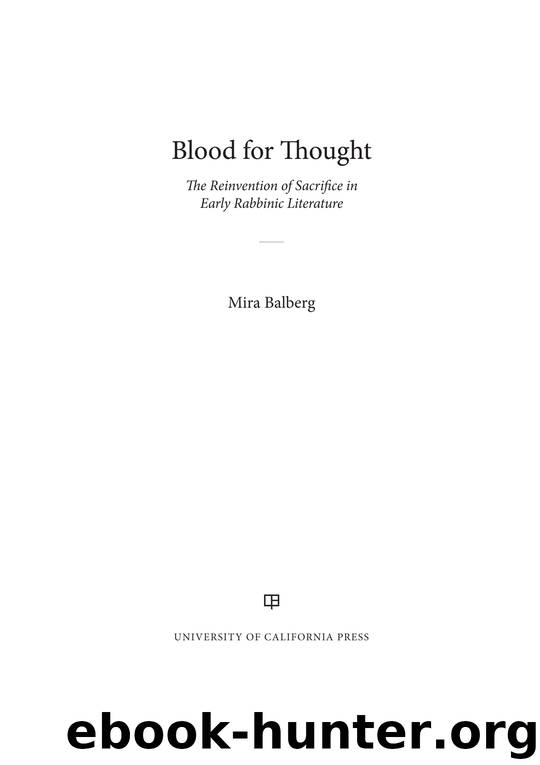Blood for Thought: The Reinvention of Sacrifice in Early Rabbinic Literature by Dr. S Balberg Mira

Author:Dr. S Balberg, Mira [Dr. S Balberg, Mira]
Language: eng
Format: epub
ISBN: 0520295927
Amazon: B074RDQRN7
Publisher: University of California Press
Published: 2017-09-26T00:00:00+00:00
Then the soldiers came and broke the legs of the first and of the other who had been crucified with him. But when they came to Jesus and saw that he was already dead, they did not break his legs. Instead, one of the soldiers pierced his side with a spear, and at once blood and water came out. . . . These things occurred so that the scripture might be fulfilled, “None of his bones shall be broken” (Exodus 12:46).121
The direct reference to blood in John’s portrayal of Jesus as the Passover lamb corresponds with the statement attributed to John the Baptist in John 1:29, “Behold the lamb of God (amnos tou theou) who takes away the sins of the world.”122 This statement casts Jesus as a “lamb” in the Levitical paradigm of a purification offering (ḥattat), whose atoning efficacy depends on the correct manipulation of its blood.
In the Synoptic Gospels, while Jesus’s death is never overtly analogized to the Passover sacrifice, the authors make notable efforts to cast the Last Supper—the account of which seems to have originally been unrelated to Passover123—distinctly as a paschal feast. Mark and Matthew mention that the meal was the Passover feast three times;124 Luke mentions this six times.125 This repetition creates a parallel between Jesus’s last supper and the Passover of Egypt, which is reenacted in the annual paschal meal. In this framework, Jesus’s statement in the course of the meal “This is my blood of the [new] covenant, which is poured out for many”126 immediately alludes to the Passover of Egypt as a time in which the first covenant was established, and to the rich blood imagery associated with that covenant. In all four Gospels, then, blood features prominently—albeit differently—in constructing a new interpretation of the Passover sacrifice and of the Passover meal. This blood-oriented interpretation fundamentally relies on a view of Jesus as a single sacrifice, whose blood was efficacious collectively.127
This blood-centered model of Jesus as a collective Passover offering is further developed in the works of Christian authors from the second century, and is specifically pitted against the Jewish sacrificial practice, which these authors deem obsolete.128 Justin Martyr in his Dialogue with Trypho insists that the injunction to sacrifice actual animals on Passover was only temporary, since the Passover of Egypt was merely a prefiguration of Christ: “The mystery, then, of the lamb which God enjoined to be sacrificed as the passover, was a type of Christ; with whose blood, in proportion to their faith in Him, they anoint their houses, i.e., themselves, who believe in Him.”129 Similarly, Melito of Sardis in his sermon Peri pascha presents the blood of the lamb (to which he refers consistently in the singular form, probaton) not only as protective of the Israelites but also as filling a function of initiation and constitution of a community.130 After the same function of initiation has been accomplished through Jesus’s blood for his believers, the Passover of the Old Testament is no longer valuable.
The early Christian
Download
This site does not store any files on its server. We only index and link to content provided by other sites. Please contact the content providers to delete copyright contents if any and email us, we'll remove relevant links or contents immediately.
| Haggadah | Hasidism |
| History | Holidays |
| Jewish Life | Kabbalah & Mysticism |
| Law | Movements |
| Prayerbooks | Sacred Writings |
| Sermons | Theology |
| Women & Judaism |
Man's Search for Meaning by Viktor E. Frankl(2254)
The Secret Power of Speaking God's Word by Joyce Meyer(2252)
Mckeown, Greg - Essentialism: The Disciplined Pursuit of Less by Mckeown Greg(2111)
MOSES THE EGYPTIAN by Jan Assmann(1970)
Unbound by Arlene Stein(1939)
Devil, The by Almond Philip C(1899)
The Complete Dead Sea Scrolls in English (7th Edition) (Penguin Classics) by Geza Vermes(1839)
I Capture the Castle by Dodie Smith(1570)
Schindler's Ark by Thomas Keneally(1513)
The Invisible Wall by Harry Bernstein(1458)
The Gnostic Gospel of St. Thomas by Tau Malachi(1412)
The Bible Doesn't Say That by Dr. Joel M. Hoffman(1372)
The Secret Doctrine of the Kabbalah by Leonora Leet(1265)
The Jewish State by Theodor Herzl(1251)
The Book of Separation by Tova Mirvis(1224)
A History of the Jews by Max I. Dimont(1206)
The Dead Sea Scrolls Bible by Martin G. Abegg(1199)
Political Theology by Carl Schmitt(1186)
Oy!: The Ultimate Book of Jewish Jokes by David Minkoff(1103)
